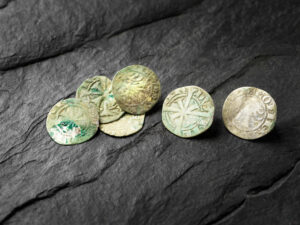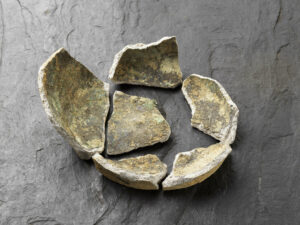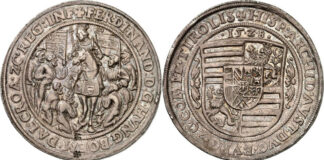In the Upper Austrian municipality of Rainbach im Mühlkreis, close to the Austrian-Czech border, a treasure was found in mid-February 2021 during construction work. The coin hoard has now been acquired by the OÖ Landes-Kultur GmbH and will be restored and examined over the next months.
The find comprises about 6,000 silver coins that had been wrapped in cloth and stored in a lidded pot made of clay. As hiding place, the owner chose a spot in the foundation of a farmhouse, and his choice proved to be so clever that the coins were not discovered for more than five centuries. At this point, we can only guess to whom the coins belonged, it is most likely that he was the owner of the farm or one of his family members. Given the size of the hoard, he certainly was not a servant.

Coins from the Second Half of the 15th Century
It is not yet know when exactly the coins were hidden. However, we can be sure that the coins are from the second half of the 15th century, the hoard consists of different coin types that were in circulation in the country at that time. These included pfennigs and half pfennigs (called “Hälblinge”), as well as larger coins worth several pfennigs, mainly Prague groschen imported from Bohemia and some Milanese pegioni, called snake groschen due to the coat of arms, and Tyrolean kreuzers, a particularly high-value coin type.

The Most Extensive Late Medieval Find From a Peasant Milieu
The question of the value of the coins is not easy to answer and will be the subject of scholarly research. At that time, the amount of the coin hoard could have been used, for example, to buy several large farm animals or several kilograms of saffron, which was a very popular spice. The hoard is one of the most extensive late medieval finds from a peasant milieu in Upper Austria and beyond.

Better Safe Than Sorry! Coins Were Hidden for Protection
At this time, we cannot say why the hoard was hidden. Until the founding of savings banks in the 19th century, people could not entrust an institution with their money. Therefore, they had to keep their property safe by hiding it. That is why hiding places were kept secret and only communicated to one or a few other people, or kept to oneself all together. If the owner died unexpectedly, for example, nobody knew where the money was hidden. Therefore, there is not always a specific reason for a historical coin find. However, it may well be that the coins were hidden because the region was located in the border area between the former Habsburg lands and Bohemia. Several warlike events took place there in the late 15th century – this might also be a possible reason for hiding the coins.
We reported on several coin finds in recent months: there were denarii in Bavaria, solidi in the Mediterranean Sea and medieval gold from Denmark.
Speaking of Austria: on 7 November 2021, the 12th coin fair takes place at Hall in Tyrol.
Right before the fair, Claire Franklin presents her new book with numismatic cartoons.




